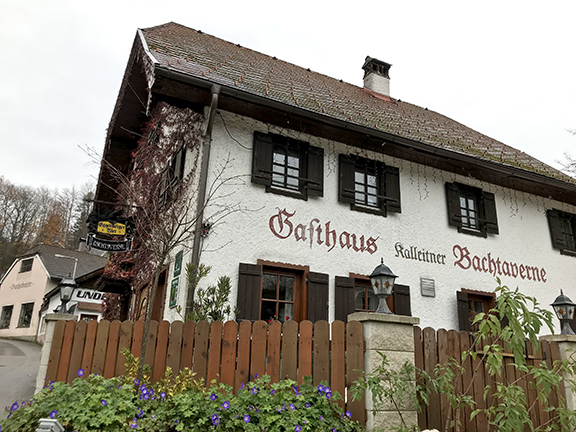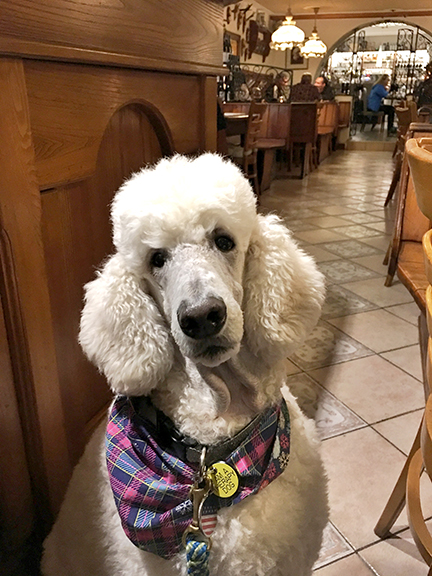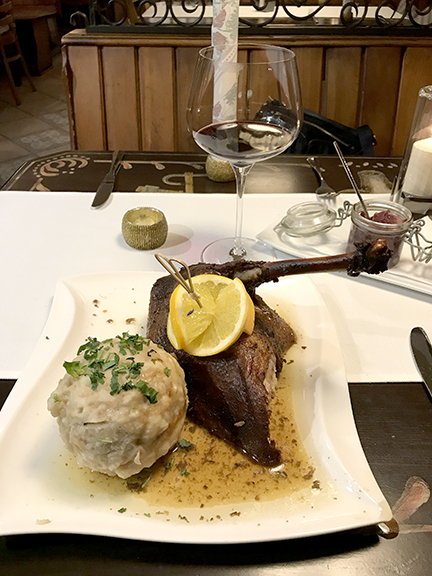It is fun learning about all of the different holidays in Austria. We started noticing a lot of restaurants with special menus posted on the door with a goose on the menu. Our German is not that great (yet!) so we weren’t really sure what the notes said. We didn’t even think to ask! Then when we were in Weyregg am Attersee we kept driving past a restaurant and the sign out front said it would open on Friday at 1800. We weren’t sure if it had been closed for the off-season (most places in Weyregg am Attersee close in the fall and don’t reopen until Advent). Since not much was open in Weyregg am Attersee and we had been cooking in for all of our meals (with farm fresh eggs and milk so I will not complain!) we decided to make Friday a big date night and go out to eat.
The restaurant we kept passing was in the small town of Bach, Austria – just up the hill from Weyregg am Attersee and it was called Bachtaverne.

And of course, James was welcome:

We were able to figure out most of the menu, but there were a few items we needed help translating. Our waiter was super helpful and it was funny that some of the foods we knew the translation and he didn’t (Kürbis was one of them – we knew this was Pumpkin in English – I love pumpkin anything in the fall and luckily a lot of Vienna had pumpkin items on their menus when we first arrived in Austria). Our waiter also said they still had Goose as a menu option, too. Where was that one? It wasn’t on the menu! So we asked about this “goose” we were seeing all over Austria and thankfully we finally had an answer.
Martinigansl (roasted goose) is the traditional dish of the season around Saint Martin’s Day. Our waiter explained it was a lot like Thanksgiving in the US but in Austria they celebrate with a goose, not a turkey. Eating the goose celebrates the end of the agrarian year and the end of the harvest. He said it is a tradition for everyone to eat goose before or on Saint Martin’s Day.
(From Wikipedia:) The goose became a symbol of St. Martin of Tours because of a legend that when trying to avoid being ordained bishop he had hidden in a goose pen, where he was betrayed by the cackling of the geese. St. Martin’s feast day falls in November, when geese are ready for killing. St. Martin’s Day was an important medieval autumn feast, and the custom of eating goose spread to Sweden from France. It was primarily observed by the craftsmen and noblemen of the towns. In the peasant community, not everyone could afford to eat goose, so many ate duck or hen instead.
Our waiter barely finished explaining the goose dish when Chris asked if I wanted that. I didn’t even let Chris finish and I said that is what I wanted! I was so excited to try the goose!
My Martinigansl (goose) dish with Knödel (like traditional US bread stuffing rolled up into a ball and one of the most delicious sides you will ever taste):

Chris had venison with these little delicious fried potatoes and similar Knödel but it was flattened into medallions and fried up a bit. It also had pear and marmalade with it:

Then for dessert we had traditional Austrian kaiserschmarrn, which are shredded caramelized pancakes dusted with sugar and powdered sugar:

This was honestly the best meal we have eaten so far in Austria! It was SO good! It is great finding amazing restaurants in the most unexpected places!

